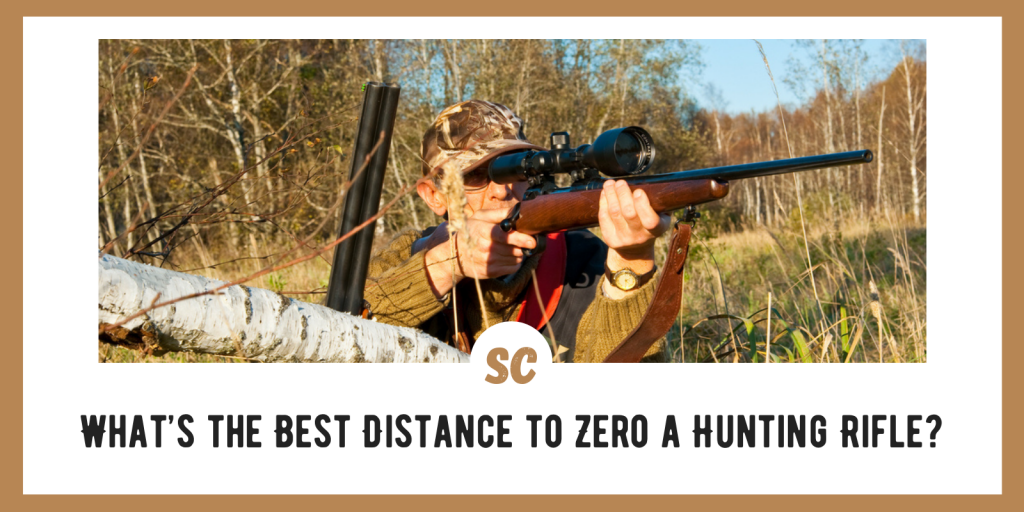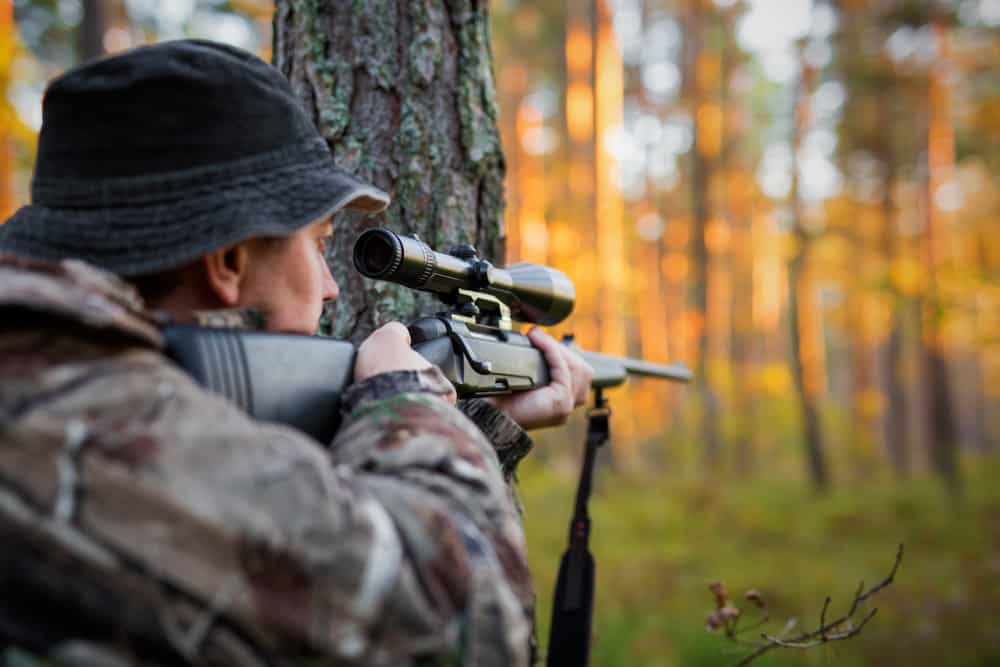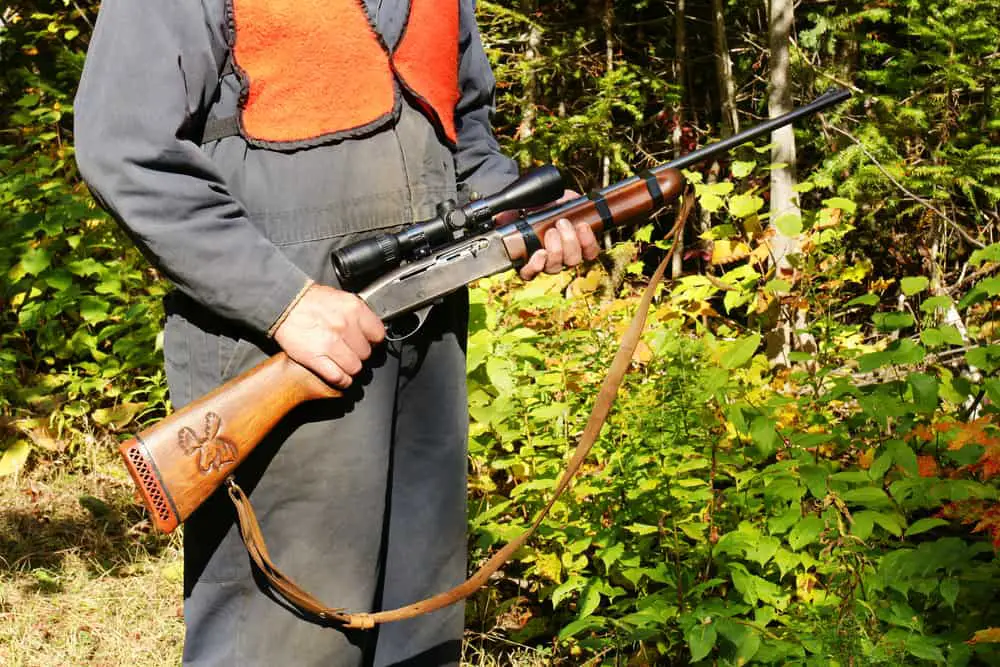Zeroing your hunting rifle is more involved than just a trip to the range and a few rounds on target. Multiple considerations affect the distance at which you chose to dial in your favorite hunting rifle and scope. Understanding how these factors affect your hunt and your preparations is key to a successful setup and maybe even a successful hunt.
In North America, the typical range at which most hunters zero their scope and rifle is 100 yards. In some cases, the range may extend out to 200 yards depending on the shooter and the type of game your hunt. For smaller game or varmints, some hunters may consider a shorter range between 50 and 75 yards.
The range at which you zero your rifle and scope is, in large part, determined by several different things. Your rifle, the caliber of ammunition, the game you are hunting, and the type of hunt you are planning all contribute to this decision. You should also think about your preferences and your comfort zone.
SKIP AHEAD
Stop Before You Zero and Decide Where to Zero
I always suggest that hunters think about their intentions and their expectations before setting up a rifle for a hunt. There is nothing more frustrating than getting into deer camp or on an extended backcountry hunt and figuring out that your rifle and scope aren’t performing up to par.
A bit of time over a cup of coffee thinking about your hunt, your rifle and scope, and your target can be invaluable when you finally get into the field. You are better prepared, your rifle and scope are ready, and you have everything set up for the animal you are after.
Think about You
Be realistic. I try never to overestimate my abilities. I am certain that every rifle and scope combination I own will shoot far better than I can. My eyesight isn’t once what it was, and neither are my reflexes. Be realistic in the expectations of your performance.
Dialing in a scope and rifle at 300 yards may be great for someone who still has 2020 eyesight and steady hands and arms. However, if you are like me and need glasses (trifocals!) and bench rest to hold a high magnification scope steady, zeroing out to three hundred yards may be pushing things a bit too far.
Zero your rifle within the limits of your abilities and your realistic expectations. In the long run, you will get more enjoyment out of your hunt and probably more success.
What is Your Quarry?
Your potential targets have a big influence on where to zero your rifle. The most hunted animals in North America are white-tailed deer and mule deer. Depending on where you hunt, the most extreme ranges for these two popular animals are between 175 yards and 250 yards.
In some areas, stand hunting is the preferred method. Some hunters still elect to stalk. In either case, hunting in a wooded area or broken terrain places natural limits on the ranges you can expect to encounter.
On the other hand, if you hunt elk in the Rocky Mountains, ranges up to 400 yards across mountain valleys may be more realistic. Varmint hunters typically shoot much shorter distances, but the targets are smaller. No matter what your game hunting involves, consider the terrain, the distances, and the targets you expect.
Your Gun and Scope
We all know and understand the importance of fitting our gun and scope to the game we want to hunt. No responsible hunter would plan on using a small caliber lightweight bullet on a big bear, elk, or moose.
Choosing the right distance to zero your rifle must also match the rifle caliber and the scope you are using. Setting up a slow, heavy caliber at 200 yards may not make sense. On the other hand, sighting in a medium-weight fast bullet at 100 yards may not take advantage of the range you get from your ammunition.
Your Typical Hunt Defines your Rifle and Scope Setup
In general, the style and type of hunt you expect are the critical defining parameters that decide where to zero your rifle. If the maximum range you expect to shoot is less than 200 yards, it doesn’t make much sense to zero your rifle at that distance.
Set up your rifle for the distances that are the most likely to present themselves during your hunt. For most North American hunters, this distance is 100 yards. This distance is well within the range variations most hunters experience during a season.
Getting to Zero Isn’t the End of the Task
Once you decide on the range at which to zero your rifle and you have been to the range and have everything dialed in, you still aren’t finished. Knowing where your bullet will strike at different distances is a key issue when zeroing your rifle. You may still have homework to do to be ready to hunt.
Understanding holdover and hold under can make a huge difference in the quality and success of your hunt. Gaining this understanding requires some knowledge of the ballistic characteristics of the ammunition you shoot.
Don’t Think in Terms of Straight Lines
The line of sight may be straight, but your bullet doesn’t follow that path. As soon as your bullet leaves the muzzle of your rifle, gravity, wind resistance and other factors begin to affect its flight. The most important of these is gravity.
The pull of gravity on your bullet pulls it down as soon as it is in free flight. The arc the bullet traces depends on the energy with which it leaves the barrel, the weight of the bullet, and some other minor factors.
For this reason, when you sight in your file, the muzzle of the gun doesn’t line up perfectly with your target. The rifle’s muzzle must point some distance above your aiming point to compensate for the arcing flight of the bullet.
Different Impact Points at Different Distances
Knowing this about your bullet’s flight lets you estimate where your bullet will impact a target set at various distances along the flight path. In general, at distances less than your zero distance, the bullet will impact slightly above the point of aim. At distances beyond zero point, your bullet will impact below the aiming point.
This knowledge is important to judge holdover or hold under if your target is not at your zero distance. Judging distance is a key factor in estimating holdover or hold under as you hunt. Misjudging the range to your target can add errors to your estimation of holdover or hold under.
The Venerable 30-06 Deer Rifle
As an example, let’s look at one of the most popular deer rifles in North America. The 30-06 has a long history among hunters in the US and continues to be a popular choice. Looking at the ballistics of a standard 30-30 cartridge can explain why ballistics is important to sighting in a rifle.
We will assume you are shooting a 165-grain boat-tail bullet from your 30-06 rifle, for our example. Typically, this bullet will show ballistic characteristics like the ones in our chart.
| Range in yards | Bullet Drop in inches | Bullet velocity |
| 0 | -1.4936 | 2800 |
| 50 | -0.1498 | 2697 |
| 100 | -0.0014 | 2597 |
| 150 | -1.1424 | 2499 |
| 200 | -3.6756 | 2403 |
| 250 | -7.7145 | 2310 |
| 300 | -13.3837 | 2218 |
| 350 | -20.8209 | 2128 |
| 400 | -30.1783 | 2041 |
| 450 | -41.6244 | 1955 |
With the rifle zeroed at 100 yards, the bullet has a relatively flat trajectory between 0 and 100 yards. At 200 yards, you would need to hold over a bit more than 3.5 inches to compensate for bullet drop. The 30-06 begins to drop off rapidly after 200 yards, and by the time it reaches 400 yards, the needed holdover is about 30 inches.
This example points out the need for understanding your bullet’s ballistic characteristics at different ranges when you are hunting. Making holdover adjustments can be critical when faced with lengthening shots.
Modern Technology to the Rescue
Many new scopes include bullet drop compensation reticles. These reticles allow calibration to make drop compensation and holdover adjustments easy on the fly. In most cases, the BDC reticle is specific to a certain caliber and bullet weight. However, some scopes include smartphone apps that give data on multiple calibers and bullet weights for the reticle adjustments.
Ballistic Calculators – A Easy as Dialing a Phone
At one time, ballistic calculators were expensive and delicate instruments used by dedicated benchrest shooters for long-distance competition. Smartphones have brought the versatility of ballistic calculators to the field and within the range of almost any shooter.
Learning to use a ballistic calculator can be an invaluable skill for many hunters. The information that a ballistic calculator can give you in the field can make your shooting more precise ad up your success rate. Many ballistic calculator apps are available for free.
Don’t Forget the Variables
Unfortunately, many other variables contribute to your rifle’s accuracy and how true to zero it shoots. Competitive long-range shooters try to eliminate as many of the variables as possible. Eliminating these variables is not a solution for hunters in the field. Understanding these variables makes it possible to deal with the inconsistencies that can occur.
- All things change – As soon as you leave the range after zeroing your rifle, things change. The changes may be minute and unnoticeable for most shooters, but these subtle changes occur for every rifle and every scope.
- Deviations in ammunition – There are always deviations in ammunition. Even the most ardent hand loaders experience slight deviations from one cartridge to the next.
- Environmental conditions – A rifle zeroed at the range at your home shooting facility on a sunny afternoon with no wind will shoot differently at 2000 feet of additional elevation on a cold December morning. Altitude, temperature, humidity, and wind contribute to variations in how a rifle, scope, and ammunition perform.
All these variables can combine to change the zero and point of impact of your rifle in the field. Understanding these issues and knowing the ballistic characteristics of your cartridge make it easier to compensate for the changes.
So, where do I Zero My Rifle?
We can’t give you a specific answer. It would be best to judge for yourself based on your planned hunt, the rifle and cartridge you shoot and your skills and abilities. We can, however, give you some general guidelines.
- For most average hunters, shooting a mid-range caliber or a larger slow-moving heavy bullet, a 100-yard zero range is usually the best choice. Deer hunters rarely need to make shoots over 250 yards, and modern mid-range caliber rifles have relatively flat trajectories at those ranges. Even the stand-by 30-30 is a good candidate for a 100 yard zero.
- Anyone hunting larger North American games like elk, moose, or bears who shoot larger caliber high-speed cartridges may do well to zero their rifles at 200 or even 250 yards. Rifles cartridges like the 300 Win Mag or the 30-06 will vary no more than 3 inches over 250 yards. At this range, the flat shooting characteristics put the bullet point impact in a good kill zone without doing any bullet drop compensation.
There are exceptions to these general guidelines. You must judge for yourself which choice is best for your skills and your rifle selection.
Add to the Conversation
Please leave your comments, suggestions, and experiences in the area below this article. We all have something to add, and your knowledge is valuable for everyone else. We hope this article answers some questions and gets you headed in the right direction as you zero your rifle for hunting. Be safe and shoot straight.





